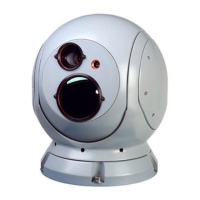77
APPENDIX A. Infrared Fundamentals
What does the SeaFLIR II Infrared camera see?
The SeaFLIR II is a passive camera that collects Infrared light. The CEU
(Control Electronics Unit) converts the light into one of 256 gray levels
and displays the information on the user’s display as an intuitive and
easy to understand image.
Infrared light is part of the Electromagnetic Spectrum. Infrared is defined
as the wavelengths between 0.75μm-1000μm (millionths of a meter).
Visible light is defined as the wavelengths between 0.4μm-0.75μm.
Infrared light can be reflected, refracted, and focused like visible light,
and travel at the speed of light in a vacuum.
The SeaFLIR II Infrared camera sees the 3.4 – 5.0μm waveband.
Every object above absolute zero (-273.16°C, -459.72°F) emits Infrared
light. Consider every object that is viewed by the SeaFLIR II Infrared
camera to be a light source. No visible light is required by the
SeaFLIR II system in order to produce a usable image. This is
especially useful in a situation where there is very little or no visible light
available.
What determines the intensity of the Infrared light from a target?
Since every object with a temperature above absolute zero emits
Infrared light, the object’s temperature has a lot to do with the amount of
Infrared light being emitted from its surface.
All surfaces do not emit light with equal efficiency. Clean, unpainted
metals tend to reflect their surroundings instead of emitting Infrared.
Most painted surfaces, human skin, rubber, concrete, plants, rocks, and
water emit Infrared light with ease.
Can the SeaFLIR II “see through walls”?
The Infrared light that the SeaFLIR II detects cannot pass through
materials typically used in wall construction.
In some situations, the SeaFLIR II Infrared camera will be able to find
different internal materials used in the wall construction (Figure A-1).
This effect is due to the differences between each material to conduct
heat (thermal conductivity). Metals generally conduct heat better than
wood, and both of them conduct heat better than insulated areas.
Commercial in Confidence
Export Level 2
Issued to: AgustaWestland
CM Ref:4049
Valid on Day of Issue only.
Document will not be updated
Uncontrolled : 4256
Retrieval Date:07-Dec-10
Requested by Bower, Richard

